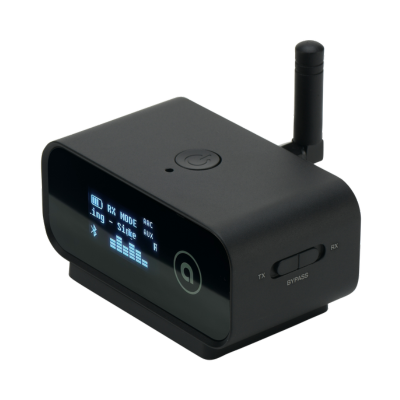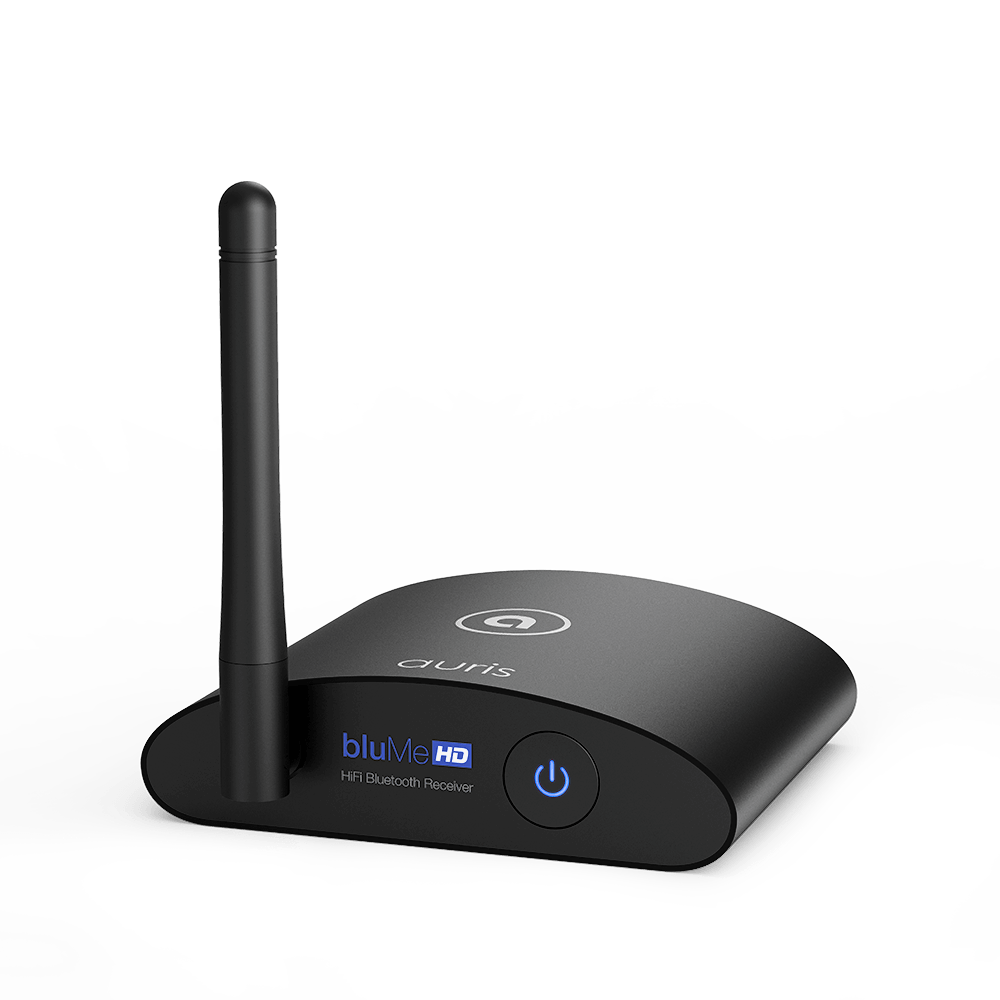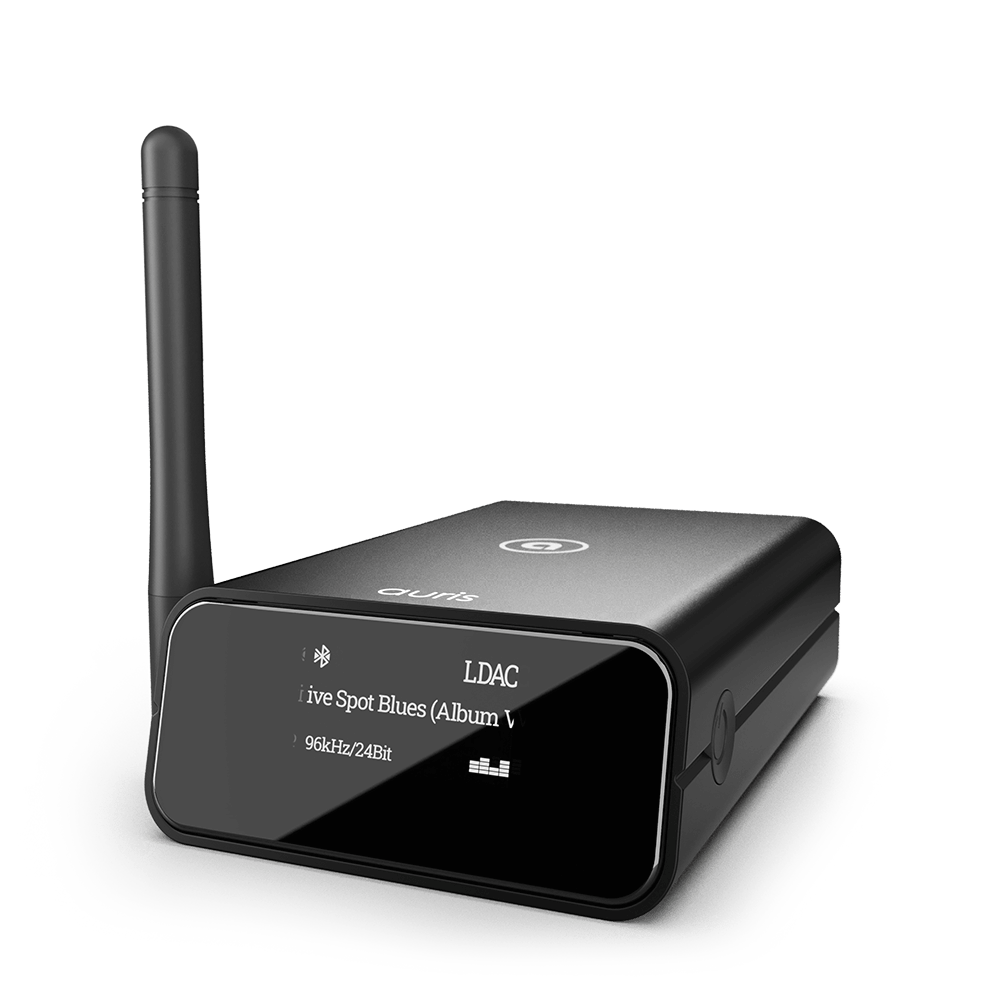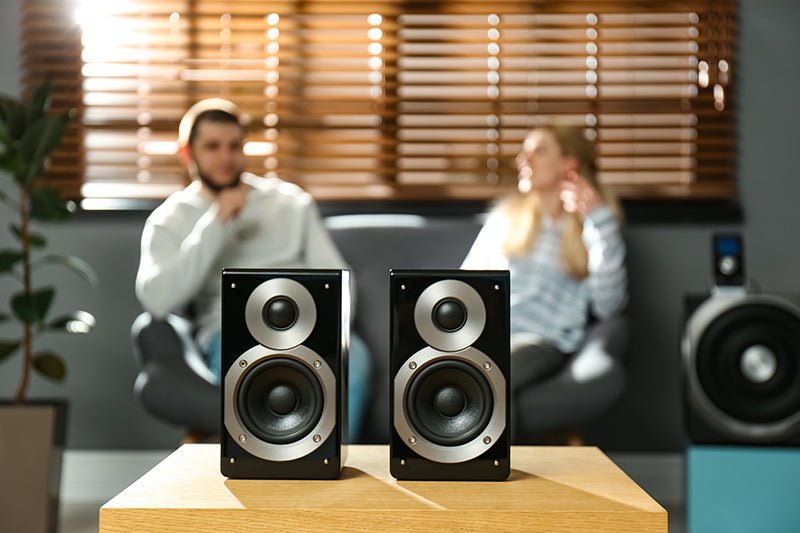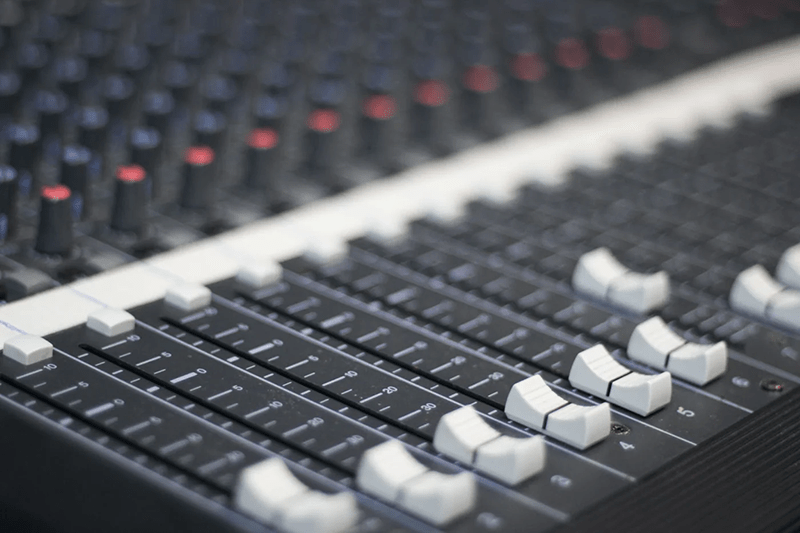
Many of us throw in a pair of headphones every day and don’t think much about the quality of the sound we’re listening to. It’s probably because you’re using a pair of headphones with a pretty decent quality sound. But trust us, when sound quality is bad, you’ll notice.
For some people, the search for high-quality, seamless, and crystal clear sound is an exciting road to follow. There is nothing better than the quality of a classic record or the boosted bass of a new pair of headphones.
If you’re starting to itch for a sound system or pair of headphones that will change the way you listen to your favorite tunes, then you’re ready to enter the world of high-fidelity sound. Let’s get you started right away.
Table of Contents
- What is Hi-Fi?
- What Makes Audio Hi-Fi?
- How to Get Hi-Fi Sound at Home
- How to Set Up a Hi-Fi Audio System for Optimal Performance
What is Hi-Fi?

Hi-fi is short for high fidelity. The fidelity of audio essentially refers to its quality, so something with high fidelity means that the sound is considered to be crisp and clean. People who love hi-fi sound are typically referred to as “audiophiles.”
You may sometimes hear the term “lo-fi,” which refers to music where deliberate “imperfections” in the audio are used as a stylistic choice. Some lo-fi music tends to have a soothing and calming effect. It’s often great for studying or trying to focus.
However, hi-fi audio is meant for people who want to get the most out of every song, show, film, or podcast that they listen to. True audiophiles would say that even “lo-fi” music is best experienced in hi-fi quality!
The History of Hi-Fi
To understand hi-fi better, it’s helpful to think about how the way we listen to music has changed over the years.
To some people, the term “hi-fi” might sound dated. It might make you think of the stereo speaker setups your parents (or grandparents) were very proud of having for their record players in the 1970s.
In fact, the term was initially coined even earlier than that, first coming into common use in the 1950s, and it remains relevant for people interested in having the best possible listening experience today — even if enthusiasts might debate exactly what it means!
For the first half of the 20th century, listening to music meant using technologies like AM radio or 78 rpm shellac records, and that meant just having to put up with distorted, distant-sounding audio.
Improvements in the technology used to record and reproduce audio made from the 1950s onward made it possible for listeners to ask for more. The goal of hi-fi audio was to get as close as possible to the experience of listening to music live, in the same room.
The next major milestone was stereo sound, which became the standard in the late 1960s, and the terms “stereo” and “hi-fi” were often used interchangeably for a time (giving rise to those systems your mom and dad were so proud of).
In the 1980s and 90s, the introduction of music recorded in digital form on compact discs (CDs) meant listeners could enjoy music without the hiss and crackling associated with vinyl records (although assumptions about the “death” of vinyl proved to be premature).
In the early 2000s, the popularity of the iPod and MP3 players gave music lovers an unprecedented ability to enjoy their favorite tunes on the go. However, it also meant an interruption in the demand from consumers for higher-quality audio.
The desire to fit more tracks into the storage space available on devices like iPods meant the use of highly compressed digital file formats, a tradeoff of quality for quantity. People were willing to accept a loss in audio fidelity if it meant they could fit more songs on their devices.
While smartphones have largely replaced those music players, the need to conserve bandwidth means that streaming music is still usually highly compressed and “lossy” (something we’ll talk about more later).
In recent years, however, hi-fi audio has been going through something of a renaissance, with many brands introducing new speakers, headphones, and other hardware catering to audiophiles and music streaming services introducing the option to stream at a higher quality level.
What Makes Audio Hi-Fi?

The quality of a sound is based on several factors, including your speaker set-up, room layout, and location of the speakers in a given space. However, it’s also based on the type of audio that your sound system can utilize.
In digital formats like CDs or streaming music, sound is transmitted as a data file before being converted into actual sound waves via your speaker. When this happens, some of the original sound quality can become diminished. This is called lossy audio.
Lossy audio generally occurs when parts of the original sound file become compressed and decompressed during transmission, causing it to lose some of its original quality. Digital and wireless/Bluetooth speakers often undergo this loss in quality because of the amount of compression necessary to transmit the audio data.
This is why most audiophiles try to look for a sound system with lossless audio, meaning that no quality is lost between the original audio recording and its playback. Lossless audio devices are your record players and analog systems that have an authentic tone. They’re pretty unmatched by most other digital devices.
Definitions
Up until now, we’ve mostly been talking about audio quality in subjective terms. So let’s get a bit more technical.
The goal of hi-fi is to reproduce audio content with minimal (and ideally no) added audible distortion or added background noise and with accurate frequency response. “Frequency response” is a term you might not be familiar with, but it can be explained fairly simply.
Frequency response is the ability to play low, middle, and high tones correctly and in proportion to each other, without highs sounding too harsh or too dull, without bass sounding too thin or too “boomy,” and without any frequencies getting too loud or too quiet relative to others.
Two other terms you might run into when you’re researching hi-fi are sample rate and bit depth. Both of these have to do with the process a DAC uses to convert a digital audio source to analog. Generally, the higher the sample rate and bit depth, the more accurate the reproduction.
Now with all of that said, the truth is that there is no single technical standard for classifying audio as “hi-fi” or “not hi-fi.”
Even defining hi-fi as recreating the experience of listening to music live and in person falls short because some listeners actually prefer the hiss of vinyl records to the “cleaner” sound of digital formats.
When we’re talking about hi-fi audio gear here on the Auris blog, however, what we’re talking about is playing audio in lossless formats at the full, original quality of the recording, without any loss or distortion introduced by the equipment.
In other words, what’s in the original recording is what you hear — nothing else and nothing less!
We think this definition gets to the heart of what our audiophile customers want without getting bogged down in debates involving lots of technical jargon.
How to Get Hi-Fi Sound at Home

With evolving technology and an increased desire for high-quality audio, there are many different options when it comes to enhancing the quality of your speaker system.
Use a Hi-fi Audio Source
No matter how good your audio setup is, your listening experience will only be as good as the quality of the recording you’re listening to.
If you’re listening to music on CD or vinyl, you don’t have to worry about losing audio fidelity to compression. But if you’re listening to music you purchased through a service like iTunes or music streaming from a service like Spotify, you need to consider the file format.
Digital audio can come in either lossy or lossless formats. Remember that these terms refer to whether any of the original recording fidelity is lost when the file is compressed to make it take up less storage space on a device or less bandwidth when streaming.
MP3 is one of the most well-known digital audio file types, but it’s highly lossy. AAC, which is the standard audio file format on many devices, offers better quality than MP3 but is still a lossy format.
The most common lossless audio formats are FLAC and ALAC. The two are almost identical, but ALAC was originally a proprietary standard developed by Apple, and Apple Music supports ALAC but not FLAC.
Due to rising demand from audiophiles, several of the most popular music streaming services, including Spotify, Apple Music, and Tidal, now offer subscription tiers with lossless audio quality.
If you want to listen to digitally purchased or streaming music through a home hi-fi setup, then research what options your preferred service offers for lossless formats.
Get the Right Speakers
One of the easiest ways to experience high-fidelity sound is to get a set of speakers that utilize lossless audio compression.
Most audiophiles probably have a record player in their home, as this is one of the most common and accessible ways to listen to clear and crisp music. Stereo systems that use analog wires are typically lossless options as well.
While this is great, the only limitation of most lossless audio options is that they are not entirely convenient. Most require you to use record players or physical cassettes to listen to your favorite music. Additionally, you need to manually change tracks by being next to the speaker itself, which can tether you down.
If you have a favorite audio system that you’re unwilling to give up, or you just want to make sure you’re hearing the highest quality sound possible, consider getting a bluMe Bluetooth music receiver from Auris.
These can connect to any digital or analog sound system and make them entirely Bluetooth compatible.
This means you can hook up your phone and listen to your favorite music streaming services, or even watch Netflix movies with low-latency sound. It connects in seconds and doesn’t require an app or wireless router, so it’s a convenient way to get the best of both worlds: high fidelity and wireless convenience.
Use an Amplifier
If your wired headphones or speakers are sounding a little lackluster, consider getting an amplifier before shelling out hundreds on a new system. Essentially, amplifiers boost the volume of certain aspects of your audio, making it feel more high quality than it originally was.
Some amplifiers can make your music loud, but you’ll still notice a bit of fuzziness to the quality. True audiophiles may also consider getting a pre-amp, which helps to reduce the noise and feedback of a sound file before it reaches the amplifier.
Many people envision amps as large, busty boxes that take up a ton of space, but modern amps are actually extremely small and easy to work with. You can even use a headphone amplifier like Amplify to take your wired headphones to the next level while making them Bluetooth compatible.
Create an Optimal Environment
Your hi-fi speaker set-up is only half of the equation: you need to make sure that your listening environment is optimal as well.
Things like couches, tables, walls, and curtains can affect the way your sound transmits throughout your space, so take some care into placing your speakers in the correct location in regards to your furniture.
It’s a good idea to make sure your speakers are not placed directly on the floor or hidden by plants and furniture.
How to Set Up a Hi-Fi Audio System for Optimal Performance
The type of speakers you own can change the way you hook up your system. If you use floor-standing speakers, you’ll have fewer options regarding where you can place them throughout your space.
This can actually be a good thing, however, as you won’t need any stands or tables to rest them on top of.
If you use bookshelf speakers or smaller Bluetooth speakers, you’ll want to invest in some speaker stands to make sure that the sound signals are sent ear-level. Be sure to angle your speakers so that they are hitting the “sweet spot” in your space.
As far as actually setting up your speakers, a good rule of thumb is to follow the equilateral triangle rule.
Put one speaker on the left side of your television or projection screen, then one more speaker on the other side. Then, arrange your furniture equidistant from both speakers so that you can draw an imaginary equilateral triangle between all three. This will make sure the sound is hitting you directly before bouncing off any obstacles.
All you need for some great hi-fi sound is a two-channel system, or two speakers on opposite sides of your viewing device (TV, projector). Surround sound will surely maximize your experience, but you don’t need to break the bank to obtain some theater-quality sound in your own home.
The main thing to keep in mind is that you’ll probably need to do a little bit of experimentation to see what types of set-ups work for you.
Try playing some music and moving around different parts of the room, trying to see where your acoustic sweet spot is. Also, don’t be afraid to test out different speakers until you can find one that suits your needs.
The Takeaway

High-fidelity audio provides a crisp, clear, and authentic sound. Audiophiles are constantly searching for the best new speakers and headphones that get them the closest to feeling like they’re actually in the recording booth listening to their favorite songs.
Hi-fi audio is usually lossless audio, meaning that none of the sound data is diminished during transmission from data file to sound wave. If you’re playing audio in digital formats, pay attention to the file type.
Record players and wired analog systems are typically the most common high fidelity audio systems, but you can use amplifiers to make wireless speakers sound just as good.
When building your hi-fi set-up, make sure you’re using the right kinds of speakers and organizing your room in such a way that the sound is enhanced. Most hi-fi systems don’t need more than just two speakers on opposite ends of your viewing device.
The bottom line is that hi-fi sound is more easily attainable than it might seem. You don’t need to spend hundreds of dollars to feel like a real audiophile.
Sources
- Why High-Fidelity Streaming Is The Audio Revolution Your Ears Have Been Waiting For | Forbes
- Sound Quality and Timbre | Georgia State University Physics and Astronomy
- Difference between Lossy Compression and Lossless Compression | GeeksforGeeks
